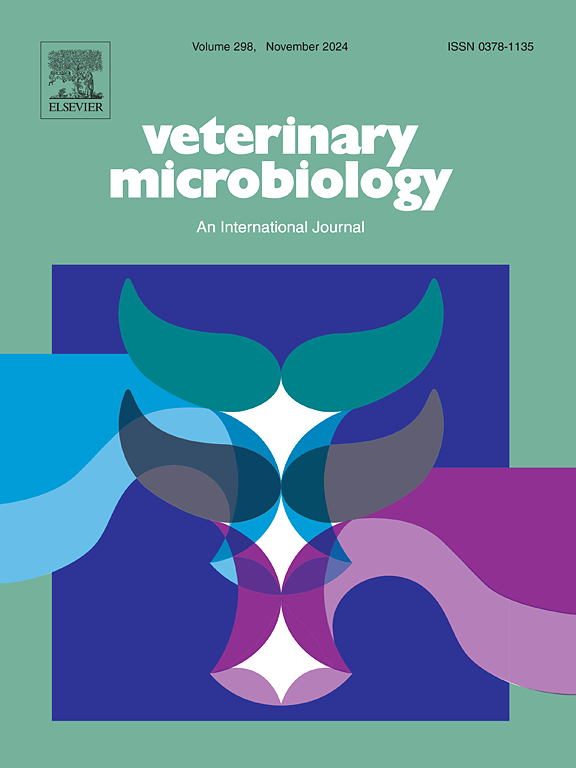Misidentification of Raoultella spp. (R. terrigena, R. planticola) and Klebsiella spp. (K. variicola, K. grimontii) as Klebsiella pneumoniae: Retrospective study of a necropsy-associated bacterial collection from horses
IF 2.4
2区 农林科学
Q3 MICROBIOLOGY
引用次数: 0
Abstract
Misidentifications as Klebsiella pneumoniae were observed during a French retrospective study of a necropsy-associated K. pneumoniae bacterial collection from horses. Accordingly, the present study aimed to further characterise the 12 Raoultella spp. and Klebsiella spp. strains involved in these misidentifications. The strains were identified and characterised using the Api 20E system, K. pneumoniae PCR detection, matrix-assisted laser desorption/ionisation time-of-flight mass spectroscopy and whole-genome sequencing. Antimicrobial susceptibilities were tested by the disc diffusion method with a panel of 40 antibiotics. Thus, misidentifications as K. pneumoniae mainly concerned Raoultella spp. (R. terrigena, R. planticola) rather than Klebsiella spp. (K. variicola, K. grimontii), with a dominance of R. terrigena. Among the 12 strains, only K. grimontii was multi-drug resistant and none were considered hypervirulent. MALDI-TOF was sufficient to avoid misidentification but commercial spectra databases should be expanded with K. grimontii and R. terrigena reference spectra to improve identification accuracy. This is probably (i) the first report of K. grimontii and R. planticola isolations from horses and (ii) the second report of R. terrigena and K. variicola isolations from horses.
将拉乌尔氏菌属(泰瑞氏克雷伯氏菌、车底克雷伯氏菌)和克雷伯氏菌属(变种克雷伯氏菌、格林蒙氏克雷伯氏菌)误认为肺炎克雷伯氏菌:对从马身上采集的与坏死性疾病相关的细菌的回顾性研究
在法国对从马身上收集的与坏死性肺炎克雷伯菌进行回顾性研究期间,发现了肺炎克雷伯菌的误认。因此,本研究旨在进一步表征12 Raoultella和Klebsiella spp.菌株参与这些错误识别。采用Api 20E系统、肺炎克雷伯菌PCR检测、基质辅助激光解吸/电离飞行时间质谱和全基因组测序对菌株进行鉴定和表征。采用圆盘扩散法对40种抗生素进行药敏试验。因此,被误认为肺炎克雷伯氏菌的主要是拉乌尔氏菌属(克雷伯氏菌属),而不是克雷伯氏菌属(克雷伯氏菌属,克雷伯氏菌属),以克雷伯氏菌属为主。12株病原菌中,只有格氏克雷蒙蒂菌具有多重耐药,没有一株具有高毒力。MALDI-TOF足以避免误认,但为了提高鉴定精度,商用光谱数据库应增加格里蒙蒂红和特里根红的参考光谱。这可能是(i)首次报道从马身上分离出格里蒙克雷伯氏菌和车车癣克雷伯氏菌,(ii)第二次报道从马身上分离出特里克雷伯氏菌和天花克雷伯氏菌。
本文章由计算机程序翻译,如有差异,请以英文原文为准。
求助全文
约1分钟内获得全文
求助全文
来源期刊

Veterinary microbiology
农林科学-兽医学
CiteScore
5.90
自引率
6.10%
发文量
221
审稿时长
52 days
期刊介绍:
Veterinary Microbiology is concerned with microbial (bacterial, fungal, viral) diseases of domesticated vertebrate animals (livestock, companion animals, fur-bearing animals, game, poultry, fish) that supply food, other useful products or companionship. In addition, Microbial diseases of wild animals living in captivity, or as members of the feral fauna will also be considered if the infections are of interest because of their interrelation with humans (zoonoses) and/or domestic animals. Studies of antimicrobial resistance are also included, provided that the results represent a substantial advance in knowledge. Authors are strongly encouraged to read - prior to submission - the Editorials (''Scope or cope'' and ''Scope or cope II'') published previously in the journal. The Editors reserve the right to suggest submission to another journal for those papers which they feel would be more appropriate for consideration by that journal.
Original research papers of high quality and novelty on aspects of control, host response, molecular biology, pathogenesis, prevention, and treatment of microbial diseases of animals are published. Papers dealing primarily with immunology, epidemiology, molecular biology and antiviral or microbial agents will only be considered if they demonstrate a clear impact on a disease. Papers focusing solely on diagnostic techniques (such as another PCR protocol or ELISA) will not be published - focus should be on a microorganism and not on a particular technique. Papers only reporting microbial sequences, transcriptomics data, or proteomics data will not be considered unless the results represent a substantial advance in knowledge.
Drug trial papers will be considered if they have general application or significance. Papers on the identification of microorganisms will also be considered, but detailed taxonomic studies do not fall within the scope of the journal. Case reports will not be published, unless they have general application or contain novel aspects. Papers of geographically limited interest, which repeat what had been established elsewhere will not be considered. The readership of the journal is global.
 求助内容:
求助内容: 应助结果提醒方式:
应助结果提醒方式:


